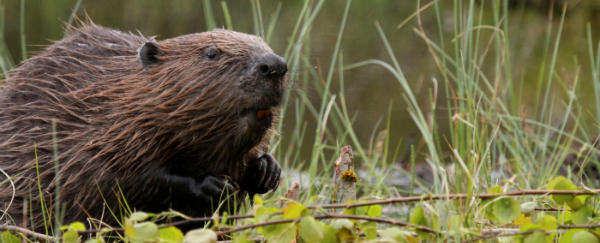Beavers’ exceptional ability to re-create diverse wetland landscapes that are home to a wide variety of species, has been revealed by researchers at the University of Stirling.
A new study, partly-funded by Scottish Natural Heritage (SNH) and published in the international journal Science of the Total Environment, is the first to fully measure these environmental benefits over time.
Scientists looked at the effects a small group of beavers had on a wetland in Tayside originally drained for farming.
Over a period of 12 years, local plant richness rose by 46% and the total number of different plants recorded more than doubled. Species which normally grow in areas with high nitrogen levels decreased, indicating a return to more natural soil conditions.
Stirling’s Professor Nigel Willby, said: “Wetlands are tremendously important environments for biodiversity. They also serve to store water and improve its quality – they are the ‘kidneys of the landscape’. However, the world’s wetlands are disappearing at an alarming rate – the latest estimates suggest that almost two thirds have been lost since 1900.
“Beavers are renowned for their engineering skills, like dam building, and are now being considered as tools for restoring wetlands. They have been reintroduced widely, including in Scotland, partly for this purpose and our findings demonstrate the surprisingly large benefits they can bring to biodiversity.”
Between 2003 and 2015, the beavers constructed 195 metres of dams, 500 metres of canals and an acre of ponds, surrounded by a mosaic of vegetation which increased in complexity by 71%.
400 years after being hunted to extinction in the UK, beavers were re-admitted to Scotland last year, based on experience from trial reintroductions. SNH will use the findings of this study to inform discussions about how the animal can be integrated within the Scottish countryside.
Solution
Stirling co-author Dr. Alan Law said: “We know lots about the benefits of beavers in natural settings, but until now we did not know the full extent of what they can achieve in present-day landscapes where restoration is most needed.
“Wetland restoration normally involves raising water levels, for example by ditch blocking, plus mowing or grazing to maintain diversity. Beavers offer an innovative, more hands-off, solution to the problem of wetland loss, provided their populations are suitably managed and protected. Seeing what beavers can do for our wetlands and countryside highlights the diverse landscape we have been missing for the last 400 years.”
The findings follows the team’s earlier research which demonstrated how beaver dams can stabilise water flows, reducing downstream flood risk and water pollution.
Background information
- The paper, Using ecosystem engineers as tools in habitat restoration and rewilding: beaver and wetlands by Law, Gaywood, Jones, Ramsay & Willby is published in the journal Science of the Total Environment.
- The initial phase of the research was done through a Natural Environment Research Council studentship part-funded by Scottish Natural Heritage (SNH).
- The follow-up phases were funded by the University of Stirling.

